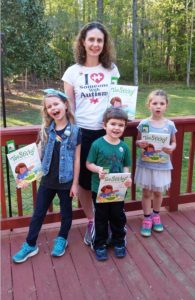
Teen Wins Award For A Coding Program
In 2020, Sreenidi Bala, a teenager from Farmington, Connecticut, started a passion project that would change the lives of hundreds of autistic students.
 My younger daughter and I were diagnosed with autism spectrum disorder (ASD) on the same day; she was 2 and I was 39. I didn’t suspect that she was autistic until she started having intense crying fits around 18 months old. I knew that these fits, often lasting 45 minutes, were not simply toddler tantrums. I felt helpless when I couldn’t calm her down. She would go through cycles of her body going limp or moving uncontrollably while she kicked and grunted. I knew I had to figure out why this was happening.
My younger daughter and I were diagnosed with autism spectrum disorder (ASD) on the same day; she was 2 and I was 39. I didn’t suspect that she was autistic until she started having intense crying fits around 18 months old. I knew that these fits, often lasting 45 minutes, were not simply toddler tantrums. I felt helpless when I couldn’t calm her down. She would go through cycles of her body going limp or moving uncontrollably while she kicked and grunted. I knew I had to figure out why this was happening.
I wasn’t satisfied with the explanation I got from medical professionals who diagnosed her with a language disorder at 2 years old. They assumed her difficulty with communication was the only cause for these fits. So I spent hundreds of hours reading medical research on my own, which led me to discover that not only was she autistic, but I was too. We both needed restricted routines, had sensory issues, engaged in repetitive behaviors, and had difficulty with social interactions—all common traits of ASD. Her fits then had a name for me—autistic meltdowns.
But getting an ASD diagnosis wasn’t easy. Some thought that we didn’t look autistic enough. We didn’t always show the same stereotypical features of autism—flapping our hands, rocking back and forth, and making poor eye contact—that even medical professionals had come to expect.
About 90 percent of the struggles I experience with my autism are internal. Autistic women and girls tend to mask autistic traits, even unknowingly, by imitating how neurotypical females act in public. This masking is what often leads women and girls to be overlooked for an ASD diagnosis. One girl is diagnosed for every four boys, according to the Centers for Disease Control and Prevention (CDC).
Getting an ASD diagnosis changed our lives for the better. I was able to understand why I always felt so overwhelmed, had trouble attending social functions, and had difficulty when my routines were disrupted. I was able to better understand my younger daughter’s needs and arrange for her to get therapies to address them. She has since learned coping strategies to regulate her emotions and reduce her autistic meltdowns.
A year after we were diagnosed, my son got his own ASD diagnosis, also at 2 years old. His diagnosis was much easier to secure, even though he has low support needs compared to many others on the autism spectrum. The main difference was that he showed more of the stereotypical features of autism—hand flapping when he got excited and some trouble maintaining eye contact.
Most recently, my oldest daughter was diagnosed with provisional ASD as well as obsessive-compulsive disorder (OCD) and attention deficit/hyperactivity disorder (ADHD). As an autistic mom of three neurodiverse kids, I’m learning a little more each day how to better address their needs.
I think in pictures and have vivid video memories that allow me to play memories in my imagination, a strength that helps me as a writer. My kids have excellent visual-spatial skills, which they use to build elaborate structures with Legos and put together complex puzzles. I want my kids to be proud of their strengths and think of their autism as part of their identity.
After my family was diagnosed, I was inspired to share our story to raise autism awareness and acceptance. As a writer, I want my kids to read other stories with characters like them so they can see themselves in books. When I couldn’t find books like this, I wrote my own children’s picture book, Too Sticky! Sensory Issues with Autism, about an autistic girl with sensory issues. My main character, Holly, is a composite character based on both my own and my daughter’s experiences living with autism and sensory issues. I named my main character and two of my other characters in the book after my kids.
In Too Sticky!, Holly has to overcome her fear of sticky hands to participate in a second-grade slime experiment at school. Truth be told, I always had more trouble with sticky hands than my daughter, and I still don’t like touching slime. I hope that autistic kids can relate to Holly’s experiences and that other kids will have a better understanding of what it is like to live with autism and sensory issues.
We’ve spent a lot of time lately reading books as a family. Like many parents under stay-at-home orders due to the COVID-19 pandemic, my husband and I are working full time with our kids also at home. The demands of our jobs haven’t given us a lot more free time, but spending time at home as a family has strengthened the bond between us and our kids. We complete school assignments, put together puzzles, practice Taekwondo, play in our wooded yard, and ride bikes on our neighborhood bike path. While I wait for the time of the coronavirus to end, I’m enjoying my time as a mother at home with my three children. We’re staying safe in the comfort of our home.
 Jen Malia is associate professor of English at Norfolk State University and the author of Too Sticky! Sensory Issues with Autism, published in April 2020 with Albert Whitman. She has appeared on “Parenting on the Spectrum” for NPR’s With Good Reason. She has written essays for The New York Times, The Washington Post, New York Magazine, Catapult, Woman’s Day, Glamour, SELF, and others. Her essays have also been published in The New York Times: Understanding Autism. She lives in Virginia Beach with her husband and three kids. You can find her on Twitter and Instagram or on her website.
Jen Malia is associate professor of English at Norfolk State University and the author of Too Sticky! Sensory Issues with Autism, published in April 2020 with Albert Whitman. She has appeared on “Parenting on the Spectrum” for NPR’s With Good Reason. She has written essays for The New York Times, The Washington Post, New York Magazine, Catapult, Woman’s Day, Glamour, SELF, and others. Her essays have also been published in The New York Times: Understanding Autism. She lives in Virginia Beach with her husband and three kids. You can find her on Twitter and Instagram or on her website.